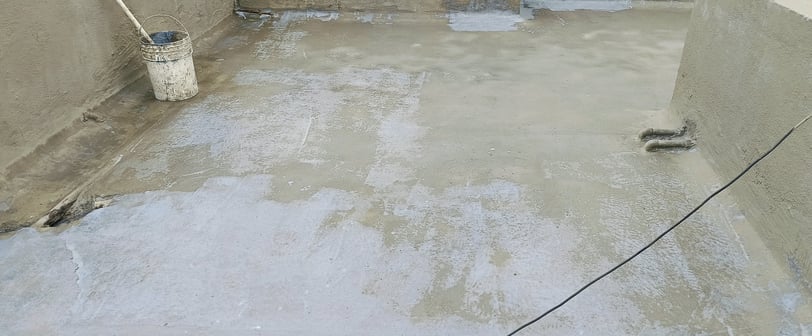2. Cementitious Waterproofing
Cementitious waterproofing is one of the most commonly used and straightforward methods for waterproofing, particularly for concrete structures. This method involves the use of a cement-based mix, which can be applied as a coating to surfaces like walls, floors, and foundations to prevent water penetration. It is often used in areas like basements, water tanks, swimming pools, and other concrete structures.


Cementitious Waterproofing:
Types of Cementitious Waterproofing
Cement-based Waterproofing Coatings
These coatings are composed of a mix of cement, sand, and water, often combined with specific chemical additives or polymers to improve flexibility, adhesion, and water resistance. The mixture forms a thick paste that is applied to surfaces in a layer to create a waterproof barrier.
Crystalline Waterproofing
This is a type of cementitious waterproofing where special chemicals are added to the concrete mix. When the concrete is exposed to water, these chemicals react with moisture and minerals in the concrete to form crystalline structures that block water pathways, creating an internal waterproof barrier. Unlike traditional coatings, crystalline waterproofing can self-repair small cracks and is ideal for structures exposed to continuous water pressure.
Key Features and Advantages of Cementitious Waterproofing
Ease of Application: Cementitious waterproofing is relatively easy to apply, often requiring only a simple mix of cement and water. Many products are available in pre-mixed forms, making the process even easier.
Cost-effective: It is one of the more economical methods of waterproofing, particularly for basic applications like foundations or concrete floors.
Durability: Cementitious coatings are highly durable, and they bond well with concrete, providing long-lasting protection against water penetration.
Non-toxic: Most cementitious waterproofing materials are non-toxic and safe for use in areas like water tanks or food storage facilities.
No Need for Specialized Skills: The application does not require highly skilled labor, and it can be done by most general contractors with experience in concrete work.
Applications of Cementitious Waterproofing
Basements: Used to prevent groundwater seepage and protect foundation walls from water infiltration.
Water Tanks: Ideal for waterproofing water storage tanks, ensuring water does not leak or become contaminated.
Swimming Pools: Cementitious waterproofing coatings are frequently used for pool structures to prevent leakage of water.
Concrete Floors: Applied to floors in areas exposed to moisture, like bathrooms, kitchens, and laundry rooms, to prevent water damage.
Foundations and Walls: Protects underground or partially submerged concrete surfaces from water damage.
Process of Cementitious Waterproofing
Surface Preparation:
The surface must be clean, dry, and free of any contaminants such as oil, dust, or grease. Any existing cracks or holes in the concrete should be repaired before applying the waterproofing coating.
Mixing the Waterproofing Compound:
The cementitious waterproofing compound is typically mixed with water to form a paste or slurry. For enhanced performance, additives like bonding agents, accelerators, or fibers may be incorporated into the mix to increase adhesion and flexibility.
Application:
The mixture is then applied to the surface using a brush, roller, or trowel. It’s important to apply the coating evenly, ensuring full coverage of the area. Several coats may be required for optimal performance, depending on the product specifications.
Curing and Drying:
After application, the coating needs time to cure. Proper curing is crucial for achieving the full waterproofing effect, and surfaces must be kept moist for a period to ensure the best results.
Inspection and Maintenance:
Once the coating has cured, the area should be inspected for any missed spots, cracks, or areas needing additional treatment. While cementitious waterproofing is low-maintenance, periodic checks are still recommended.
Limitations of Cementitious Waterproofing
Limited Flexibility:
Cementitious coatings can be prone to cracking if the underlying concrete shifts or moves, as they are not as flexible as other waterproofing methods, such as liquid membranes or rubberized coatings.
Surface Preparation:
The success of cementitious waterproofing depends on thorough surface preparation. If the concrete is not cleaned properly or if cracks are not repaired beforehand, the coating may not adhere well, leading to potential failures.
Water Pressure:
While cementitious waterproofing is effective for preventing water infiltration under normal conditions, it may not perform as well under high water pressure or in highly saturated environments, where other more robust systems (such as membrane systems) may be necessary.
Requires Re-coating:
Over time, cementitious waterproofing may wear down, particularly in areas exposed to heavy moisture. It might require re-coating every few years depending on the conditions.
